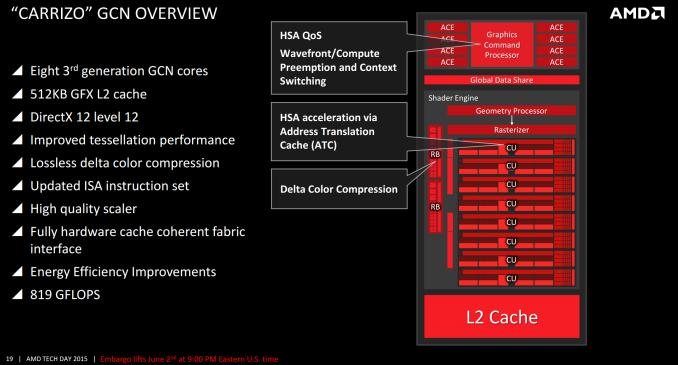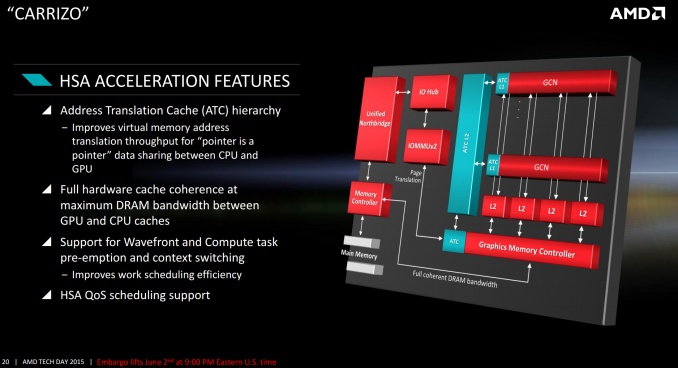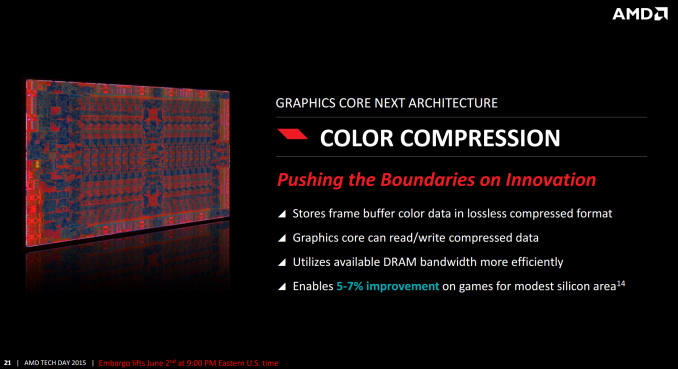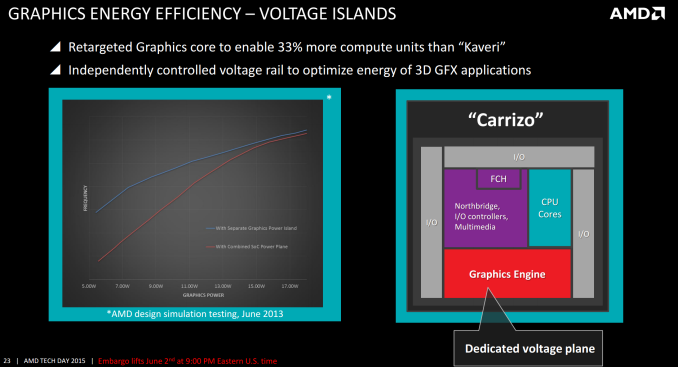AMD Launches Carrizo: The Laptop Leap of Efficiency and Architecture Updates
by Ian Cutress on June 2, 2015 9:00 PM ESTGraphics
The big upgrade in graphics for Carrizo is that the maximum number of compute units for a 15W mobile APU moves up from six (384 SPs) to eight (512 SPs), affording a 33% potential improvement. This means that the high end A10 Carrizo mobile APUs will align with the A10 Kaveri desktop APUs, although the desktop APUs will use 6x the power. Carrizo also moves to AMD’s third generation of Graphics Core Next, meaning GCN 1.2 and similar to Tonga based retail graphics cards (the R9 285).
This gives DirectX 12 support, but one of AMD’s aims with Carrizo is full HSA 1.0 support. Earlier this year when AMD first released proper Carrizo details, we were told that Carrizo will support the full HSA 1.0 draft as it currently stands as it has not been ratified, and they will not push back the launch of Carrizo until that happens. So there is a chance that Carrizo will not be certified has a fully HSA 1.0 compliant APU, but very few people are predicting major changes to the specification at this point before ratification that requires hardware adjustments.
The difference between Kaveri’s ‘HSA Ready’ and Carrizo’s ‘HSA Final’ nomenclature comes down to one main feature – context switching. Kaveri can do everything Carrizo can do, apart from this. Context switching allows the HSA device to switch between work asynchronously while it waits on the other part that needs to finish. I would imagine that if Kaveri came across work that required this, it would sit there idle waiting for work to finish before continuing, which means that Carrizo would be faster in this regard.
One of the key parts of HSA is pointer translation, allowing both the CPU and GPU to access the same memory despite their different interpretations of how the memory in the system is configured. One of the features on Carrizo will be the use of address translation caches inside the GPU, essentially keeping a record of which address points to which data and when an address is in a lower cache, that data can be accessed quicker. These ATC L1/L2 caches will be inside the compute units themselves as well as the GPU memory controller and an overriding ATC L2 beyond the regular L2 per compute unit.
Use of GCN 1.2 means that AMD can use their latest color compression algorithms with little effort – it takes a little more die area to implement (of which Excavator has more to play with than Kaveri), but affords performance improvements particularly in gaming. The texture data is stored losslessly to maintain visual fidelity, and move between graphics cores in this compressed state.
In yet more effort to suction power out of the system, the GPU will have its own dedicated voltage plane as part of the system, rather than a separate voltage island requiring its own power delivery mechanism as before. AMD’s latest numbers on the improvements here only date back to June 2013 via internal simulations, rather than an actual direct comparison.
All the performance metrics rolled in, and AMD is quoting a 65% performance improvement at 15W compared to Kaveri. The adjustment in design is allowing higher frequency for the same power, combined with the additional compute units and other enhancements for the overall score. At 35W the gain is less pronounced, but more akin to regular generational improvements anyway. What we see at 35W is what we would normally expect, and it pales in comparison to the 15W numbers.















137 Comments
View All Comments
renegade800x - Thursday, June 4, 2015 - link
Although viewable it's far from being "perfectly" fine. 15.6 should be FHD.albert89 - Tuesday, June 23, 2015 - link
You don't need a strong CPU since win8 because most laptops use atom, Celeron or Pentium processors. AMD APU's are the natural choice !mabsark - Wednesday, June 3, 2015 - link
AMD should make Steam Box's. They already do APUs, chipsets (which are going on die) and memory. It would be pretty simple for AMD to partner with a motherboard maker. Imagine a Steam Box about the size of a router, with a nano-ITX motherboard, a 14 nm APU with HBM, wifi, a few USB ports and an HDMI port to connect to a TV.An AMD/Valve partnership could potentially revolutionise the console market, providing cheap yet powerful and efficient console-type PCs.
Refuge - Wednesday, June 3, 2015 - link
HBM isn't coming to APU's anytime soon.Cryio - Saturday, June 6, 2015 - link
Probably the first APU after Carrizocoder111 - Wednesday, June 3, 2015 - link
Aren't Steamboxes supposed to run Linux?AMD drivers for Linux are a bit weird. Catalyst is the official supported driver but it's buggy.
Open source drivers are quite good but they are slower than Catalyst and don't support latest OpenGL spec. There is no Mantle/Vulcan/HSA/Crossfire support with Open-Source drivers either. OpenCL is in alpha stage.
So AMD would need to man up and do the Linux drivers properly. They are working on it and making good progress but I doubt it is ready to be used at the moment as it is...
Besides, lots of games these days get developed with Nvidia's "help" to ensure they run well on Nvidia GPUs and run like crap on AMD GPUs. And if the games are built using Intel Compiler, they'll run like crap on AMD CPUs as well. All of these tactics are anticompetitive and should be illegal IMO but who said the world is fair...
And don't get me wrong, I love AMD, I use Linux + AMD dGPU + APU, but I don't think it's ready for the masses yet.
AS118 - Wednesday, June 3, 2015 - link
I agree. I'm a double AMD Linux gamer and I've run into the exact same problems as you have, and I wish they'd be more serious about Linux. Sure they have Microsoft's support, but I feel that they should take Linux more seriously outside of the enterprise (where they do take Linux more seriously).yankeeDDL - Wednesday, June 3, 2015 - link
I disagree.For casual gaming on laptops, 1366x768 is just fine. You'll need a lot more horsepower to drive a fullHD screen and battery life will suffer.
I won't say that there's no benefit gaming at fullHD vs 1366x768: obviously, the visuals are better, but if you want an "all rounder" laptop which does not weight one ton (like "real" gaming laptops) and that it is below $500, it's not bad at all.
BrokenCrayons - Wednesday, June 3, 2015 - link
I personally would rather have a cheap 1366x768 panel. I don't care about color accuracy much, light bleed, panel responsiveness or much of anything else and haven't since we transitioned from passive to active matrix screens in the 486 to original Pentium era of notebook computers. In fact, I see higher resolutions as an unnecessary (because I have to scale things anyway to easily read text and interact with UI elements and because native resolution gaming on higher res screens demands more otherwise unnecessary GPU power) drain on battery life that invariably drives up the cost of the system to get otherwise identical performance. The drive for progressively smaller, higher pixel density displays is a pointless struggle to fill in comparable checkboxes between competitors to appease a consumer audience that has been swept up in the artificially fabricated frenzy over an irrelevant device specification.yankeeDDL - Wednesday, June 3, 2015 - link
I think it depends on the use, ultimately.For office work (i.e.: much reading/writing emails), a reasonably high resolution helps making the text sharp and easier on the eyes.
For home use (web browsing, watching videos, casual gaming) though, I find it a lot less relevant.
Personally, at home, I rather have a <$400 laptop always ready to be used for anything, to be moved around, even in the kitchen, than a $1000 laptop which I would need to treat with gloves for fears of damaging. Since Kaveri I also started recommending AMD again to my friends and family: much cheaper than Intel and with a decent GPU makes them a lot more versatile. Again, my opinion, based on my use. As they say: to each his own...